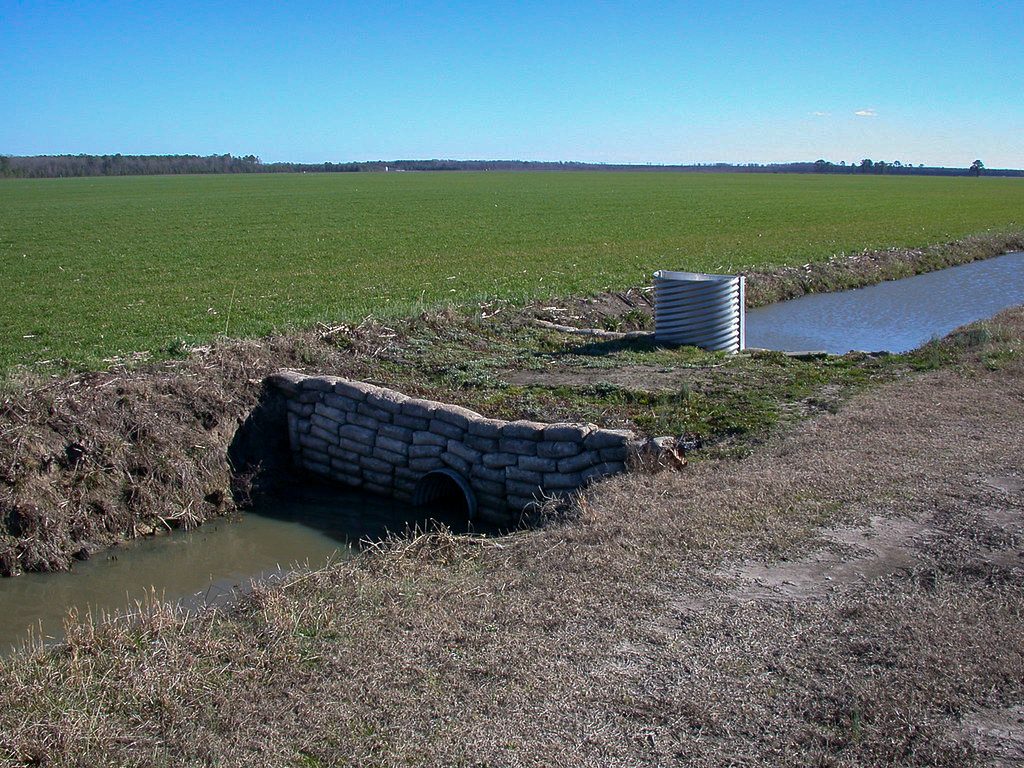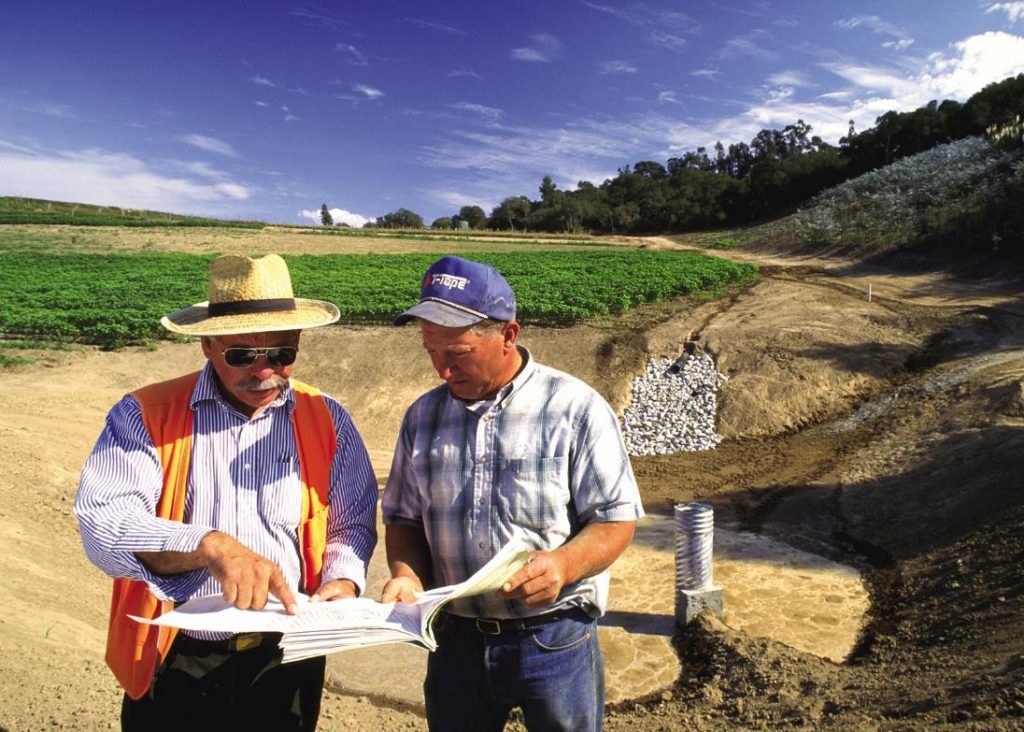7 Conservation Practices for Construction Sites and Disturbed Areas
Colby Moorberg
Abbreviations
NRCS – Natural Resources Conservation Service
PAM – Polyacrylaminde
PDF – Portable Document Format
RUSLE – Revised Universal Soil Loss Equation
SWPPP – Stormwater Pollution Prevention Plan
URL – Uniform Resource Locator
US – United States
USDA – US Department of Agriculture
Erosion Control and Stormwater Pollution Prevention
US EPA. 2007. Developing Your Stormwater Pollution Prevention Plan. 50. Washington, D.C.: EPA. https://www.epa.gov/sites/production/files/2015-10/documents/sw_swppp_guide.pdf.
This guide from the EPA is designed for construction site operators who control construction plans or supervise day-to-day construction site activities. The guide will help with developing a quality stormwater pollution prevention plan (SWPPP) and is applicable to any construction site required to comply with stormwater discharge requirements. The 50-page guide is divided into 9 chapters. Chapters 1 and 2 provide an overview and describe under what conditions an SWPPP is required. The guide then covers site assessment and planning; selecting erosion and sediment control best management practices; choosing good housekeeping best management practices; inspecting and maintaining an SWPPP as well as recordkeeping; certification and notification; implementation; and final stabilization and permit termination. The URL offers a direct download of a PDF of this resource.
US EPA. 2015, October 26. Developing a Stormwater Pollution Prevention Plan (SWPPP). https://www.epa.gov/npdes/developing-stormwater-pollution-prevention-plan-swppp.
This web page contains links to resources for developing an SWPPP. It contains the SWPPP guide described above (EPA 2007), as well as example SWPPPs for various scenarios. Each are available as PDF downloads.
USDA NRCS. 2000. Erosion and Sedimentation on Construction Sites. 5. Auburn, AL: USDA NRCS Soil Quality Institute. https://www.nrcs.usda.gov/Internet/FSE_DOCUMENTS/nrcs142p2_053285.pdf.
This Urban Technical Note from the USDA NRCS Soil Quality Institute provides a brief description of erosion in the context of construction sites. This includes describing the on-site and off-site damage caused by erosion. The RUSLE model is described as an option for modeling erosion under different practices. The technical note also includes 13 principles for construction erosion control. The URL offers a direct download of a PDF of this resource.
Anionic Polyacrylamide Application
King, S., and R. McLaughlin. 2015. Fiber Check Dams and Polyacrylamide for Water Quality Improvement. Raleigh, NC: NC State University. https://content.ces.ncsu.edu/fiber-check-dams-and-polyacrylamide-for-water-quality-improvement.
In this Soil Facts extension bulletin from North Carolina State University, King and McLaughlin describe the use of fiber check dams as a best management practice for disturbed areas. It includes a spacing guide for fiber check dams of different sizes based on the slope of the channel. Maintaining fiber check dams is discussed, followed by information on reducing turbidity through the use of (Anionic Polyacrylaminde (PAM), a synthetic polymer that binds clays and fine silts to facilitate flocculation and settling of those particles.
McLaughlin, R. 2014. Chemical Turbidity Control in Pumped Construction Site Water. Raleigh, NC: NC State University. https://content.ces.ncsu.edu/chemical-turbidity-control-in-pumped-construction-site-water.
In this Soil Facts extension bulletin from North Carolina State University, McLaughlin provides an overview of techniques for reducing sediment in stormwater runoff from construction sites. Sediment basins and sediment bags are described, but McLaughlin states that these practices don’t always reduce turbidity of stormwater runoff from construction sites on clays and fine silts. McLaughlin then describes methods of dosing runoff using pump injection of PAM and solid PAM dosing using bricks or powder.
McLaughlin, R. 2015a. Chemical Treatment to Control Turbidity on Construction Sites. Raleigh, NC: NC State University. https://content.ces.ncsu.edu/chemical-treatment-to-control-turbidity-on-construction-sites.
This extension bulletin from North Carolina State University highlights three types of chemical treatments used to reduce turbidity of stormwater runoff from construction sites. McLaughlin describes the use and effectiveness of PAM, gypsum (CaSO4), and alum (Al2(SO4)3), but PAM is the primary focus of this extension bulletin.
McLaughlin, R. 2015b. Using Polyacrylamide (PAM) to Reduce Erosion on Construction Site. Raleigh, NC: NC State University. https://content.ces.ncsu.edu/using-polyacrylamide-pam-to-reduce-erosion-on-construction-sites.
In this Soils Facts extension bulletin from North Carolina State University, McLaughlin provides a concise summary of the properties of PAM and how it can be used on construction sites to reduce erosion. McLaughlin describes how PAM can be used to keep soil in place, typically be being applied to disturbed soil in conjunction with mulches and other types of groundcover.
USDA NRCS. 2016a. Anionic Polyacrylamide (PAM) Application. Conservation Practice Standard 450. 4. Washington, D.C.: USDA. https://www.nrcs.usda.gov/wps/PA_NRCSConsumption/download?cid=nrcs143_026468&ext=pdf.
In this conservation practice standard, the USDA NRCS defines Anionic Polyacrylaminde (PAM) as a chemical that can be applied to soils to reduce erosion and increase infiltration rates. The USDA NRCS further describes the uses of PAM, the conditions under which it can be used, and the criteria that must be met for it to be used as a conservation practice. Ways in which PAM can be applied without risk to human health and the environment are also described. The URL offers a direct download of a PDF of this resource.
USDA NRCS. 2016b. Anionic Polyacrylaminde (PAM) Application. Conservation Standard Practice Overview. 1. Washington, D.C.: USDA. https://www.nrcs.usda.gov/wps/PA_NRCSConsumption/download?cid=nrcseprd1298028&ext=pdf.
In this conservation standard practice overview, the USDA NRCS describes how to use PAM to reduce irrigation-associated erosion or erosion on disturbed areas. A concise summary of general information on the practice is provided. Conservation practices commonly associated with PAM include sprinkler, surface, and subsurface irrigation. The URL offers a direct download of a PDF of this resource.
Diversion

USDA NRCS. 2009. Chapter 9 Diversions. In Engineering Field Handbook, 30. Washington, D.C.: USDA NRCS. https://directives.sc.egov.usda.gov/OpenNonWebContent.aspx?content=25756.wba.
This chapter from the Engineering Field Handbook provides technical guidance for diversions that direct water downslope. The chapter begins with how to assess a site for its suitability for diversions. The chapter then outlines planning and preliminary design, design itself, installation, and maintenance of diversions.
USDA NRCS. 2016a. Diversion. Conservation Practice Standard 362. 4. Washington, D.C.: USDA. https://www.nrcs.usda.gov/wps/PA_NRCSConsumption/download?cid=stelprdb1254995&ext=pdf.
This conservation practice standard from the USDA NRCS defines diversions as channels running across a slope with a ridge on the lower side. Diversions serve many purposes, but most relate to either interrupting water flow down a slope, or directing water to a desired location. The standard then outlines information on criteria for implementing the practice, considerations, plans and specifications, and operation and maintenance. The URL offers a direct download of a PDF of this resource.
USDA NRCS. 2016b. Diversion. Conservation Practice Standard Overview 362. 1. Washington, D.C.: USDA. https://www.nrcs.usda.gov/wps/PA_NRCSConsumption/download?cid=nrcs143_026408&ext=pdf.
This conservation practice standard from the USDA NRCS defines diversions as channels running across the slope with a ridge on the lower side. The overview also contains concise, general information on the practice. Conservation practices commonly associated with diversions include grassed waterways, terraces, water storage facilities, and underground outlets. The URL offers a direct download of a PDF of this resource.
Mulching

Babcock, D., and R. McLaughlin. 2008. Mulch Options for Erosion Control on Construction Sites. 5. Raleigh, NC: NC State University. https://content.ces.ncsu.edu/mulch-options-for-erosion-control-on-construction-sites.
In this extension bulletin from North Carolina State University, Babcock and McLaughlin outline considerations for and effectiveness of three types of mulches: loose mulch, erosion control blankets, and hydraulically applied mulches (hydromulches). For each of the three mulch types, Babcock and McLaughlin state that long-term effectiveness depends on slope preparation and correct installation. In addition, site managers should consider soil preparation before establishing a seedbed for long-term cover.
USDA NRCS. 2017a. Mulching. Conservation Standard Practice 484. 4. Washington, D.C.: USDA. https://www.nrcs.usda.gov/wps/PA_NRCSConsumption/download?cid=nrcseprd1335267&ext=pdf.
In this conservation practice standard, the USDA NRCS defines mulching as applying plant residue or other materials to the soil surface. Mulching serves a variety of purposes, including improving moisture, reducing erosion, and improving efficiency of irrigation water. The standard outlines criteria for using this conservation practice, considerations for the practice, plans and specifications, and operation and maintenance. The URL offers a direct download of a PDF of this resource.
USDA NRCS. 2017b. Mulching. Conservation Standard Practice Overview 484. 1. Washington, D.C.: USDA. https://www.nrcs.usda.gov/wps/PA_NRCSConsumption/download?cid=nrcseprd1344016&ext=pdf.
In this conservation practice standard overview, the USDA NRCS defines mulching as applying plant residues and other substrates to the land surface. The overview includes information on why and when the practice should be used. Commonly associated practices listed in this overview include critical area planting, diversion, and establishing trees/shrubs and windbreaks/shelterbelts. The URL offers a direct download of a PDF of this resource.
Structure for Water Control

USDA NRCS. 2017a. Structure for Water Control. Conservation Practice Standard 587. 4. Washington, D.C.: USDA. https://www.nrcs.usda.gov/wps/PA_NRCSConsumption/download?cid=nrcseprd1335271&ext=pdf.
In this conservation practice standard, the USDA NRCS defines a water control structure as a structure in a water management system that conveys water and controls the direction or rate of flow to maintain a desired water surface elevation or to measure water. The standard describes where the practice applies, criteria used for implementing the practice, considerations, plans and specifications, and operation and maintenance. The URL offers a direct download of a PDF of this resource.
USDA NRCS. 2017b. Structure for Water Control. Conservation Practice Standard Overview 587. 1. Washington, D.C.: USDA. https://www.nrcs.usda.gov/wps/PA_NRCSConsumption/download?cid=nrcseprd1349213&ext=pdf. The URL offers a direct download of a PDF of this resource.
The USDA NRCS defined water control structures in this conservation practice standard overview as a structure in a water management system that conveys water and controls the direction or rate of flow to maintain a desired water surface elevation or to measure water. The overview also includes a concise description of how water control structures are used with other considerations. Conservation practices associated with water control structures and listed in this overview include dikes, subsurface drains, wetland restoration, and open channels. The URL offers a direct download of a PDF of this resource.
Water and Sediment Control Basin

McLaughlin, R., and A. Jarrett. 2008. Surface Outlets for Sediment Basins. Raleigh, NC: NC State University. https://content.ces.ncsu.edu/surface-outlets-for-sediment-basins.pdf.
This brief Soil Facts extension bulletin from North Carolina State University describes surface outlet skimmers for sediment basins. These are dewatering systems for sediment basins that function by removing the cleanest water from the surface of the basin while leaving water with the heaviest suspended sediment in the basin longer to allow additional sediment to fall out of suspension. Several pictures demonstrate the function of these skimmers. The bulletin closes with links to four resources related to sediment control basins. The URL offers a direct download of a PDF of this resource.
McLaughlin, R. 2015. Using Baffles to Improve Sediment Basins. Raleigh, NC: NC State University. https://content.ces.ncsu.edu/using-baffles-to-improve-sediment-basins.
This extension bulletin from North Carolina State University outlines the use and types of baffles within sediment basins as a best management practice that decreases the sediment load in stormwater runoff. Baffles function by slowing the movement of water through the basin and converting turbulent water flow into laminar water flow. This allows sediment to settle out faster. Two types of baffles are described: solid baffles and porous baffles. Several figures and images show what these baffles look like, how they function, and how they are installed.
USDA NRCS. 2016a. Sediment Basin. Conservation Practice Standard 350. 4. Washington, D.C.: USDA. https://www.nrcs.usda.gov/wps/PA_NRCSConsumption/download?cid=stelprdb1254985&ext=pdf.
This conservation practice standard from the USDA NRCS defines sediment basins as basins with an engineered outlet, constructed using a dugout, an embankment, or both. The purpose of sediment basins is to capture sediment-laden runoff and debris long enough to allow settling within the basin. The standard goes on to describe where the practice applies, criteria for its implementation, considerations for the use of sediment basins, plans and specifications, and operation and maintenance. The URL offers a direct download of a PDF of this resource.
USDA NRCS. 2016b. Sediment Basin. Conservation Practice Standard Overview 350. 1. Washington, D.C.: USDA. https://www.nrcs.usda.gov/wps/PA_NRCSConsumption/download?cid=nrcs143_026289&ext=pdf.
This conservation practice standard overview from the USDA NRCS defines sediment basins as basins with an engineered outlet, constructed using a dugout, an embankment, or both. The overview provides a brief description of the practice, where it applies, and how it is implemented. The overview also includes a list of commonly associated practices, including critical area planting, mulching, and structure for water control. The URL offers a direct download of a PDF of this resource.

